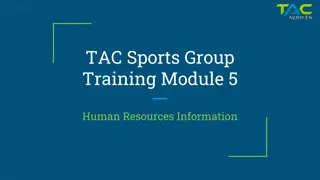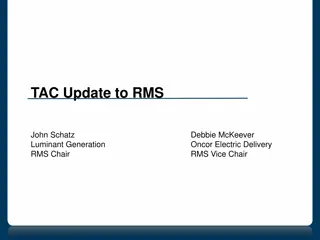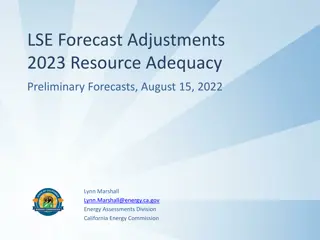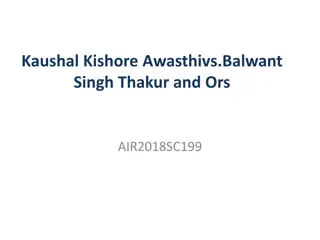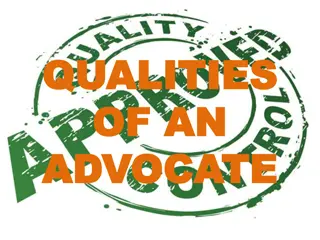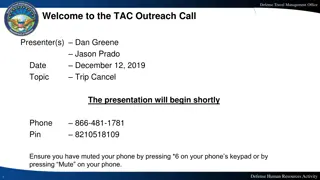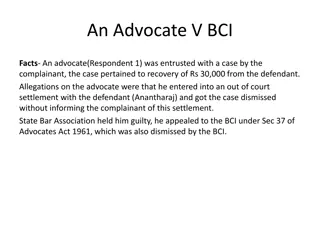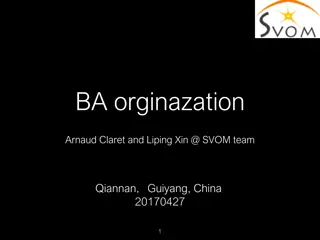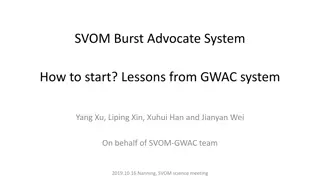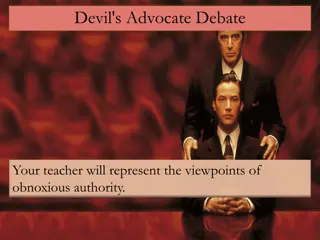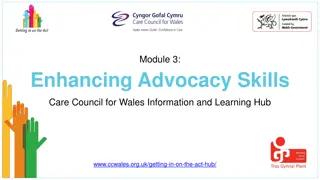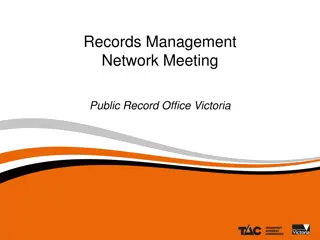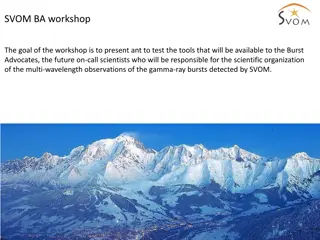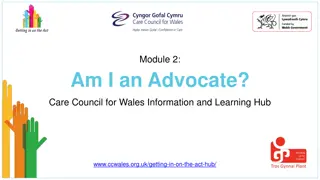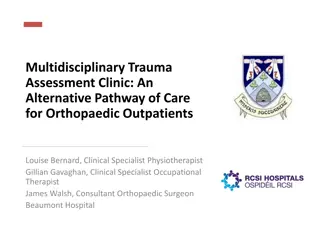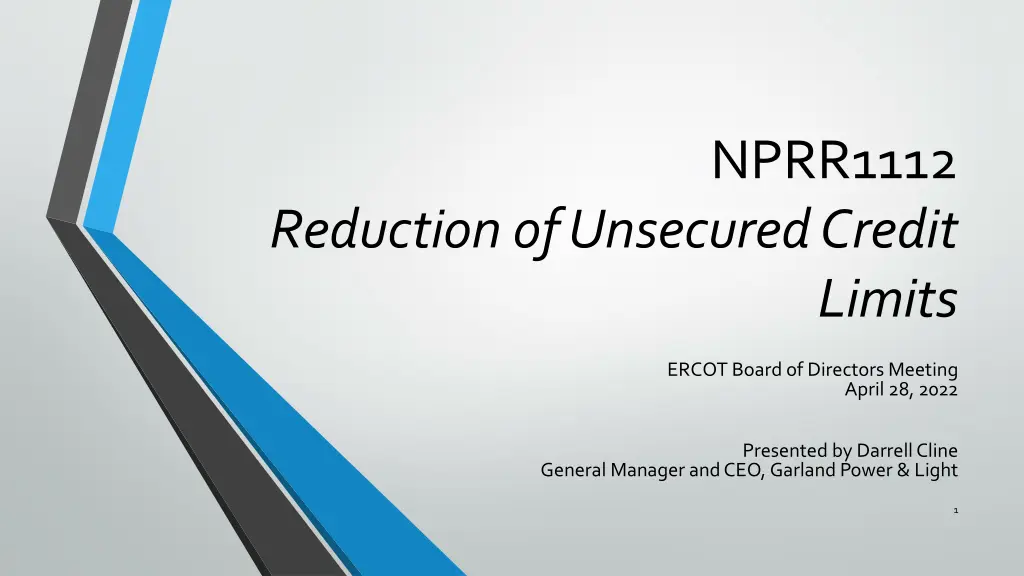
ERCOT Unsecured Credit Limits Reduction Overview
Explore the details of NPRR1112, the reduction of unsecured credit limits at the ERCOT Board of Directors meeting. Learn about the background, Credit Work Group discussions, proposed limit changes, and post-Uri legislative actions. Gain insights into the decision-making process and the financial implications involved.
Download Presentation

Please find below an Image/Link to download the presentation.
The content on the website is provided AS IS for your information and personal use only. It may not be sold, licensed, or shared on other websites without obtaining consent from the author. If you encounter any issues during the download, it is possible that the publisher has removed the file from their server.
You are allowed to download the files provided on this website for personal or commercial use, subject to the condition that they are used lawfully. All files are the property of their respective owners.
The content on the website is provided AS IS for your information and personal use only. It may not be sold, licensed, or shared on other websites without obtaining consent from the author.
E N D
Presentation Transcript
NPRR1112 Reduction of Unsecured Credit Limits ERCOT Board of Directors Meeting April 28, 2022 Presented by Darrell Cline General Manager and CEO, Garland Power & Light 1
What is Unsecured Credit Credit that is backed by the credit rating or credit worthiness of the borrower rather than by assets held by the borrower Commonly used by Market Participants (MP) in lieu of cash or Letters of Credit to secure bilateral agreements Provided by all other Independent System Operators (ISOs) in the United States, up to $50 million ERCOT currently provides up to $50 million in unsecured credit to Market Participants with: Investment grade credit ratings; or Unrated municipals or cooperatives that meet financial requirements in Section 16.11.2 (2) (a) and (b) of the ERCOT Protocols The amount of unsecured credit allowed is based on the MP s financials 2
Background Winter Storm Uri was a devastating event that caused billions in economic damages 36 of 37 Market Participants who had unsecured credit during the Winter Storm have paid their bills in full The remaining Market Participant with unsecured credit that has not yet paid has ongoing litigation with ERCOT and a disputed balance No more than $50M of the $1.9B in dispute is impacted by unsecured credit (less than 2.7% of the total) December 2021: ERCOT proposed the elimination of unsecured credit Referred to Credit Work Group (Credit WG) who unanimously endorsed retaining unsecured credit with a $30 million limit reduced from $50 million Protocol Revision Subcommittee (PRS) endorsed (90.5%) the reduction of the unsecured credit limit to $30 million Technical Advisory Committee (TAC) recommended approval (92%) of the reduction of the unsecured credit limit to $30 million To-date, no party has filed comments in support of ERCOT s position 3
Credit Work Group Credit Work Group (Credit WG) is established by the Board and reports to the Financial & Audit Committee Credit WG members must have credit-related qualifications and experience Credit WG considered NPRR1112 at three separate meetings ERCOT presented to the January 19, 2022 meeting of the Credit WG. A motion was made to table NPRR1112 and submit a proposal to lower the unsecured credit limit cap On February 2, 2022 a group of joint commenters filed a revision to lower the cap by 45% to $27.5M At its February 16, 2022 meeting, the Credit WG voted to Endorse NPRR1112 Revising Proposed Limit from $27.5M to $30M March 15, 2022 Credit WG comments (emphasis added) Credit WG can support retaining the existing credit limit or a reduction to $30M. Based on information reviewed to date, Credit WG has not seen evidence of a material improvement in credit risk due to the reduction or elimination of unsecured credit. 4
Post-Uri Legislative Reforms Have Been Significant in Reducing Credit Risk Mandated weatherization of generation and transmission facilities Lowered the overall system-wide offer cap, limited its potential duration, and capped ancillary service (AS) prices These changes alone would have significantly reduced total cost exposure of Winter Storm Uri Removal of highly volatile retail plans Still to come: market redesign; year-round weatherization standards; supply chain mapping; improved coordination with gas industry 5
Credit Rating Agencies Recognize Recent Reforms to Reduce Risk Fitch Ratings on March 28, 2022: Operating risk will remain elevated for ERCOT utilities, and Fitch will continue to factor it into individual credit profiles. However, the utilities have largely financed storm costs long-term, raised rates where needed, and taken steps to reduce market exposure. This points to an improving credit environment that could stabilize Rating Outlooks over time. The winterization of generation assets, market reformsandstepstaken by the utilities to hedge supplies should materiallyreduce financial exposure to future winter storm events, said Senior Director Kathy Masterson. Similar outage events could still occur in ERCOT, but financial costs would be reduced. 6 Fitch Ratings, 28 March 2022 Source
Eliminating Unsecured Credit Does Not Materially Improve Credit Risk in ERCOT Approximately $420mm remains in default that occurred from Winter Storm Uri excluding Brazos* None of these parties were extended unsecured credit Other, more appropriate vehicles exist to target credit risk NPRR1067, Market Entry Qualifications, Continued Participation Requirements, and Credit Risk Assessment A comprehensive study of credit best practices As evidenced by the Credit Work Group s comments, elimination of unsecured credit does not materially improve credit risk in ERCOT 7 * Estimation from ERCOT s Dec. 2, 2021 Market Bulletin, removing amounts from Brazos Electric, Rayburn Country and Hanwha Energy
Eliminating Unsecured Credit Will Have Unintended Consequences Failure to Differentiate Creditworthiness Less Market Liquidity Increase in Cost to Consumers 8
Failure to Differentiate Creditworthiness Elimination of unsecured credit is ERCOT s attempt to provide a more level playing field and prevent subsidization of other Market Participants This attempt eliminates the current process that properly differentiates a Market Participant s creditworthiness and effectively places an investment grade entity above a non-investment grade entity ERCOT s proposal could require a Market Participant with a non- investment grade credit rating to post the same security as a Market Participant with a AAA credit rating ERCOT s proposal is a step backward in properly differentiating risk between entities based on their creditworthiness ERCOT s proposal does not align with its stated objective of credit best practices to reduce the risk of future under-collateralization 9
Less Market Liquidity Elimination of unsecured credit will reduce liquidity in the ERCOT Market, which could increase cost of transacting in ERCOT for Market Participants and electric consumers in ERCOT In setting the current $50 million unsecured credit limit for the other ISOs, FERC recognized that unsecured credit provides liquidity to wholesale energy markets * The $50 million cap was an appropriate balance between the costs that would need to be incurred by market participants to provide this level of secured credit and the effects of potential market disruption under a market participant default event * FERC Docket RM10-13-000; Order 741; PP 50 10
Increased Costs for Consumers Secured credit creates an expense that must be recovered from consumers Market Participants with investor grade ratings will need to seek secured credit from a limited number of financial institutions increasing exposure to financial institutionsand financial institutions to ERCOT Many of the affected Market Participants have higher credit ratings than the financial institutions from whom they would have to seek credit under ERCOT s proposal Secured credit will increase costs to electricity consumers without any appreciable benefit in reducing risk 11
Market Participants Bear the Risk for Non- Performance by Counter-Parties If a Market Participant exits the market without resolving its obligations, it is other Market Participants that must pay default uplift charges Both the Credit Professionals and Market Participants which bear the uplift risk, have voted to retain unsecured credit ERCOT is not at risk of financial default as a result of extending credit to qualified Market Participants; this posture makes ERCOT a neutral party to extending credit on behalf of other Market Participants No evidence of exit or refusal to enter the ERCOT market by entities because of perceived risk of unsecured credit extension on their behalf To date, there have been no Market Participants who have filed comments in support of ERCOT s position to terminate the extension of unsecured credit Market Participants did, however, speak through their votes: Initial vote to approve ERCOT s language was rejected by 84% Vote to approve Technical Advisory Committee (TAC) version was 92% in favor 12
TAC Endorsed Version Represents Reasonable Compromise TAC endorsement to reduce the total unsecured credit from $50M to $30M is made in a spirit of compromise All other ISOs/RTOs that extend unsecured credit are capped at $50 million. Unsecured credit limit is reduced 40% to reflect commensurate change in the high system-wide offer cap from $9,000/MWh to $5,000/MWh TAC believes this proposal is appropriate in view of PUC s work to lower market price exposure Acknowledges ERCOT s concerns but ensures appropriate credit diversity to mitigate against increased exposure to financial institutions 13
Conclusion Credit rating agencies recognize meaningful reforms in reducing risk Eliminating unsecured credit does not materially improve credit risk in ERCOT Eliminating unsecured credit will result in unattended consequences, such as: failure to differentiate creditworthiness; less market liquidity; and increase in costs to consumers Other more comprehensive NPRRs are more appropriate vehicles for specifically targeting meaningful credit risk such as NPRR1067, Market Entry Qualifications, Continued Participation Requirements, and Credit Risk Assessment TAC recommends the Board approve NPRR1112 as endorsed by the Credit Working Group on March 14, 2022 and as endorsed by TAC on April 13, 2022 14
Appendix Rebuttal of ERCOT s April 21, 2021 Comments 15
a.) Since Independent System Operators/Regional Transmission Operators (ISO/RTOs) function as central clearinghouses, there is no inherent reason why ISO/RTOs should provide free credit for some Market Participants. Since banks are in the business of understanding and pricing credit risk, they are better positioned to provide credit support for Market Participants. ERCOT is not providing free credit support for Market Participants. Market Participants are responsible for payment of defaults. If there is a concern by ERCOT with the ability to accurately gauge credit risk, it would be more appropriate for ERCOT to perform a comprehensive study of credit best practices, rather than entirely eliminating unsecured credit. 16
b.) The availability of Unsecured Credit Limits is in effect a shifting of the credit risk and associated costs of some Market Participants to others, since all Market Participants must share in default uplift costs. There is no cost to ERCOT or Market Participants in making unsecured credit available. ERCOT s proposal fails to differentiate creditworthiness between Market Participants, effectively equating an investment grade and creditworthy entity s ability to pay with that of a lower creditworthy entity. The elimination of unsecured credit results in cost increases to Market Participants. 17
c.) Highly-rated Market Participants eligible for Unsecured Credit Limits should be able to obtain replacement financing from eligible letter of credit- issuing banks. If such a bank is unwilling to execute a letter of credit with one of these Market Participants, it is doubtful whether the overall ERCOT wholesale market should be financing their credit risk at no cost to the Market Participant. Highly-rated and creditworthy Market Participants will be able to get letters of credit, but at a cost that will be unnecessarily borne by their ratepayers or customers. These Market Participants are already paying a cost to maintain their high credit rating and creditworthiness. 18
d.) Relatedly, ERCOT creditworthiness requirements for banks issuing letters of credit are, in the aggregate, more stringent than those currently used to grant Unsecured Credit Limits. Therefore, it can be expected that elimination of Unsecured Credit Limits, and assumption of those credit risks by banks, would improve ERCOT s overall credit profile. To illustrate this, the percentage distribution by credit rating of Counter-Parties with Unsecured Credit Limits compared to banks with currently posted letters of credit is shown below. Under current Protocols, a financially strong entity should receive more unsecured credit than a financially weaker entity. The Protocols currently allow for entities to not receive unsecured credit based on their financial position. If the concern is that the current Protocols are not appropriately reflecting the credit risk of entities, it would be more appropriate for ERCOT to perform a comprehensive study of credit best practices, rather than entirely eliminating unsecured credit. 19
e.) It has been suggested that NPRR1112 is unnecessary since ERCOT has discretionary authority under Section 16.11.2, Requirements for Setting a Counter-Party s Unsecured Credit Limit, to set Unsecured Credit Limits, and under Section 16.11.4.1, Determination of Total Potential Exposure for a Counter-Party, to revise Total Potential Exposure to reflect a Counter-Party s financial risk. Historically, ERCOT has interpreted these provisions as providing responses to specific market-related risks (e.g. an unexpected bankruptcy filing), rather than providing means to set overall credit policy. As such, ERCOT does not believe that discretionary authority was meant to apply broadly as a net but rather as a spear. Notwithstanding allowable discretionary authority, ERCOT believes that NPRR1112, as amended by the 3/18/22 ERCOT comments, is an appropriate credit policy. This concern can be alleviated by clarifying the existing discretion that ERCOT is granted in the Protocols rather than a blanket elimination of unsecured credit. 20
f.) A stakeholder at TAC asserted that ERCOTs assumption of credit risk via unsecured credit is costless. This is belied by the fact that, as Market Participants readily agree, they would be charged by banks for letters of credit. If there were no cost for credit support and the assumption of credit risk, then banks would have no reason to charge for letters of credit. Provision of unsecured credit does not make the cost of credit risk vanish; instead, it socializes that cost among other Market Participants. There is no cost to ERCOT or Market Participants in making unsecured credit available. ERCOT correctly identifies that there will be costs and these costs will be unnecessarily borne by ratepayers or customers; in particular for highly-rated and creditworthy Market Participants that are already paying a cost to maintain their high credit rating and credit worthiness. 21
g.) Some stakeholders also argued that the cost of credit support by banks would increase costs to end-use consumers. Consistent with paragraph (f) above, ERCOT believes that elimination of Unsecured Credit Limits will not increase the cost of ERCOT market credit risk in the aggregate, but rather reallocate that cost in an appropriate and non-distortive manner. Costs will be increased for highly rated and creditworthy entities and will be unnecessarily borne by ratepayers or customers. ERCOT s proposal fails to differentiate creditworthiness between Market Participants, effectively equating an investment grade and creditworthy entity s ability to pay with that of a lower creditworthy entity, which will be distortive and not reflective of its stated objective of credit best practices to reduce the risk of future under- collateralization . 22
h.) Some stakeholders further stated that actions taken by the PUC since the 2021 extreme winter weather event, such as the reduction in the System-Wide Offer Cap, have reduced credit risk in the ERCOT wholesale market to the extent that Unsecured Credit Limits remain justifiable. Notwithstanding changes made since the winter event, ERCOT wholesale market credit risk has not been eliminated. Market Participant defaults may be driven by any number of factors outside the scope of ERCOT market design, such as poor hedging strategies, and therefore the ERCOT wholesale market should maintain a conservative credit risk profile. As recognized by rating agencies, the actions taken by the State Legislature and PUC since Winter Storm Uri have been viewed as credit positive. These actions taken have reduced credit risk that was present when the unsecured credit limit was $50M. Through the ERCOT committee process, Market Participants have expressed a willingness to continue to extend unsecured credit to Market Participants even at a lower level. With a lower overall credit risk profile driven by market changes already in place, and with future market changes that are expected to also improve the credit risk profile, removing unsecured credit from the market is an effort that is moving in an opposite direction of the risk profile of the overall market. 23

